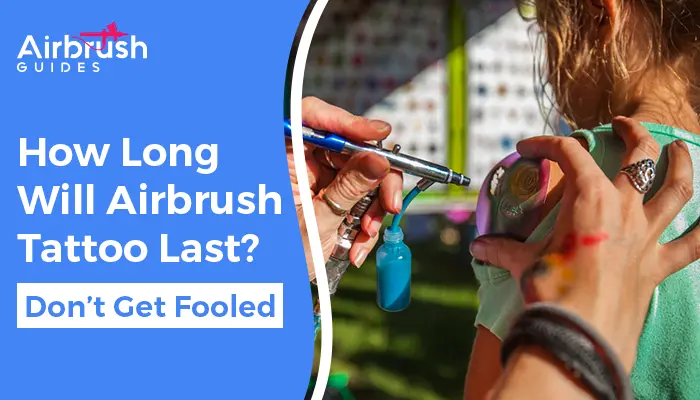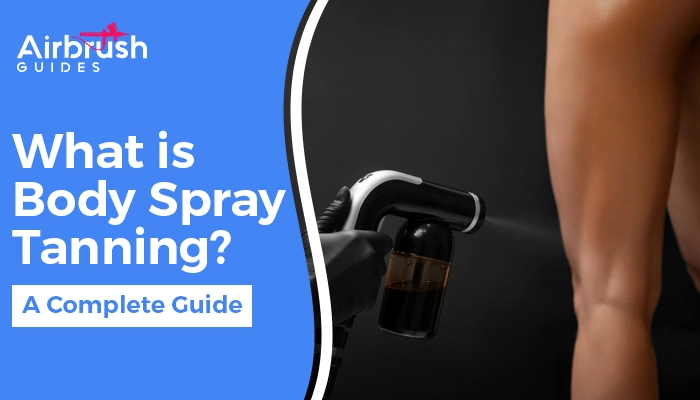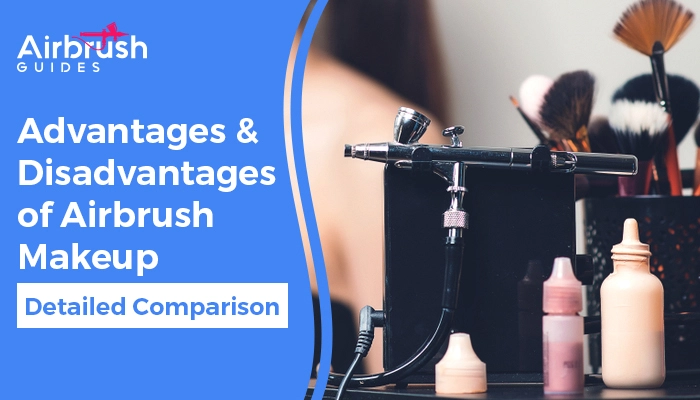Can You Airbrush Indoors? Airbrush Guides
Airbrushing is a fun task when you want to color miniatures or pots and other such things in your home. Generally, people use airbrushes outdoors to color or paint their equipment, but there are some folks who want to paint things indoors using their airbrushes. They often ask, can you airbrush indoors? The problem with painting indoors is that paint that might get inhaled while sprayed using an airbrush.
This raises the issue of whether or not you ought to put on a respirator or airbrush mask. Continue reading to learn more about airbrushing inside and what measures should be taken to stay safe.
Airbrushing Paint Indoors: The Process
If there is improper ventilation in the room where you are airbrushing, you need to consider how many chemicals will accumulate there. Your furniture may not be at risk from the atomized paint, but your lungs might suffer long-term damage. Acrylic airbrushing inside, in our experience, is less harmful than airbrushing enamels. Acrylics that are spray-canned appear slightly nastier than acrylics that have been airbrushed.
Fumes and micro-particles are the two things you should watch out for. Acrylic paint can lessen the likelihood of fumes, but paint particles can and will still get into your lungs. Despite the fact that lacquers, for example, are more poisonous than acrylic, inhaling sprayed paint is not something you want to do. However, some acrylic paint containers still include a “Warning” protocol. Because of this, we decide to spray with caution.
How To Paint Indoors Using Airbrush?
Before you begin airbrushing at home, we advise you to follow these steps.
Wear A Mask
Without a mask, you can get migraines when you spray acrylic or a clad on the miniatures. These headaches can be rather severe. There will always be sprayed paint particles in the air, regardless of how well-ventilated your space is. To stop such particles from getting into your lungs, these masks have filters attached. Additionally, they are inexpensive.
Any brush is generally discolored after a 20-minute airbrushing session, and paint often gets on the needle opening and the cup. This paint is difficult to remove. We don’t want the same paint to adhere to our nose, lungs, or throat. Manufacturers of the most inexpensive respirator masks advise discarding them after several hours of usage because they are disposable. They aren’t horrible; they’re simply not made to be used frequently.
You can choose to get a better mask since you spend a lot of time airbrushing at home, and while disposable ones are less expensive, you will still need to buy another one, which adds up over time. You can go for two inexpensive airbrushes: one that will keep you safe for a while and one that, provided the filters are replaced, will last a lifetime. Both are excellent, but if you want to spend a lot of time airbrushing, you would either get the inexpensive ones in large quantities or choose the full-face piece straight away.
Respirator With Two Cartridges
When the vapor cartridges are empty, which should take roughly 40 hours of use, this mask is designed to be thrown away. When using the Dual Cartridge, we haven’t even the least hint of a headache or odor. If you can smell something even when wearing the mask, it’s time to replace it and toss the old one away.
Full Face Mask by 3M
The full face mask has everything you need to keep yourself safe while airbrushing; it covers your eyes, lungs, neck, and nose.
Utilize A Spray Booth
For your small paintwork, it might be a good idea to think about acquiring a spray booth in addition to the mask. The spray booth will give you and those around you a ventilated, safe environment to airbrush miniatures while the mask guards your lungs. Hours after lacquer has been applied, the odors continue to linger in the space. Ventilation is necessary to remove them. A spray booth resembles a portable airbrush studio since it has filters to catch all the dust.
The spray booth’s fan will manage overspray and remove the odors from your workstation. To do this, open a window and direct the vent hose directly out the window for the length of your brushing session. This will minimize the amount of spray, stink, and debris that enters your apartment. Warhammer models and miniatures may easily be airbrushed at home, and many models include a turntable and LED lights.
The spray booth that you have to use must be large enough to accommodate most models, making it the ideal portable workplace for you. You haven’t painted anything that was excessively huge yet, but if you did, the spray booth could be connected to another unit to make a bigger space.
Why Using A Respirator When Airbrushing is Recommended?
Wearing a mask is essential whenever paint is atomized because dangerous vapors may enter the air. You should use a specially made airbrush mask or respirator when airbrushing with the color of your choice. The mask aids in preventing inhalation of any fumes or extra paint. There are several types of paint, and some are riskier to use than others. Some could argue that it is not necessary to wear a suitable mask while using water-based acrylic paints.
The paint is regarded as non-toxic because it is water-based. Sadly, each paint product has a different level of toxicity; thus, all paints should be thought of as poisonous to some extent.
Which Type of Mask is Required For Airbrushing?
The risks of spraying paint and the protective equipment that should be worn may not be clear to individuals who go from painting with a brush to airbrushing. Today’s market has a sizable selection of non-toxic airbrush paints, but there are still risks because spray painting isn’t just dangerous because of the toxicity of the paint, as we first believed. But it turns out that because the lungs can’t handle the chemicals, breathing paint particles poses just as big of a risk as being exposed to them.
Wearing a mask is the most straightforward approach to prevent all of this. When it comes to safety, cost shouldn’t usually be a deciding factor, but in this situation, we’re in luck because most masks are reasonably priced given the service they offer. There are several kinds of masks and filters that can filter various kinds of particles, vapors, and gases. You need a mask with filters that can handle both the particles and the fumes when airbrushing.
We would advise using one of two masks since they have every feature we want in a painting respirator. The mask must be NIOSH-approved, and it must be made apparent that it may be used for spray painting, among other requirements. A NIOSH rating of at least N95 is required for the mask. It is impossible to determine whether the mask’s capacity to filter out particles has been evaluated without the rating.
The three letters N, R, and P are used to rate masks. They are used to assess the mask’s oil resistance. N stands for not resistant, R for somewhat resistant, and P for oil-resistant. Having to deal with a continuous buildup of fog when spray painting may be pretty annoying. The mask should not have sharp edges and fit comfortably, even when worn for a long time. Backup filters should be readily accessible care to prevent having to buy new masks each time the purifiers need to be replaced.
The mask shouldn’t fog up too much. It is preferable that the mask is produced by a well-established company because it is much easier to find replacement parts for popular masks both locally and online.
Things to Think About While Airbrushing
The paint will be atomized or broken up into smaller particles when you use your airbrush tool. Consequently, there are two things you should be mindful of while airbrushing:
Overspray
This phrase refers to paint particles that don’t always go where you want them to. The paint can be thought of as really tiny paint droplets on things that weren’t your target. The majority of the atomized paint falls in the desired location, but some droplets will escape and fall outside the target region. If you don’t have the right airbrushing mask on, you risk breathing in the paint in the air. The respiratory system and lungs may be harmed by this.
Fumes
Vapors and fumes that the paint emits have the potential to be hazardous. You may purchase a number of paints, all of which can release dangerous vapors. Water-based acrylic paints are the least harmful type of paint you may use. They don’t emit a lot of fumes or unpleasant scents. The solvent-based paints, such as urethanes or enamel airbrush paints, on the other hand, emit some really poisonous fumes. Long-term lung damage will result from these fumes.
It is advisable to wear an airbrushing mask that shields you from hazardous fumes and overspray when you know what kind of paint you will be using. Although safeguarding your eyes is equally vital, we are primarily concentrating on lung protection.
FAQ’s
- Airbrushing: Is it messy?
We doubt it will come as a surprise that spraying paint is more difficult to manage than applying it with a brush. Your approach, method, level of competence, and level of preparation will determine how much messier airbrushing is. The less time you have to spend cleaning up the overspray, the more prepared you are. From a clean-up standpoint, choosing an appropriate area to airbrush in is crucial.
A large garage or lawn will have enough room to protect the environment around you as you airbrush, but smaller, more crowded spaces will probably result in more undesirable paint stains, especially without a spray booth.
- Does Airbrushing Require Ventilation?
To ensure appropriate air circulation, you need unquestionably to make sure the area you airbrush in is well-ventilated. By allowing fresh air to circulate through the space, the accumulation of gases and smells will be lessened. The ventilation required to reduce the build-up will be provided by opening windows, doors, and an industrial fan.
Conclusion
The article explains that one can you airbrush indoors? Everything that is required as a safety concern and the proper way to airbrush indoors has been explained properly here. If you need more info on airbrushing, see FAQ.




